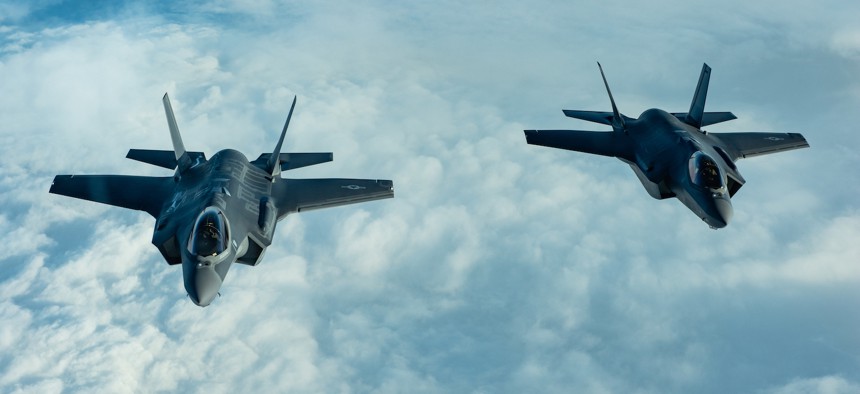
Two F-35A Lightning IIs fly over the Atlantic Ocean in 2018. U.S. Air Force photo by Airman 1st Class Alexander Cook
Island-Hopping F-35s Test Pacific Air Forces’ Agility Concept
A pair of jets flew two missions from different airfields on the same day in a bid to complicate Chinese targeting.
Pacific Air Forces, which is striving to be able to orchestrate a strike campaign from multiple far-flung island bases faster than a highly capable enemy like China can target them, tested the concept in last week’s Cope North exercise.
“We flew our [two] F-35s from Eielson Air Force Base in Alaska down to Andersen Air Force Base, Guam, and the very next day they took off on a mission, executed the mission but then landed in Palau,” Gen. Kenneth S. Wilsbach, commander of Pacific Air Forces, said during an Air Force Association event on Wednesday. “There was one of our C-130s that refueled them while they were running. They were on the ground for less than an hour, took off again and executed another mission back to Anderson.” said
It’s a big test for a new concept called Agile Combat Employment, or ACE, which seeks to make command posts a lot more mobile. Wilsbach described it as an essential innovation to stay ahead of more advanced militaries such as China’s. “A big portion of Agile Combat Employment is you don’t always go back to where you started from…so making it difficult for an adversary to figure out where you are, how long you’re going to be there, exactly where on the airfield you are…You complicate the targeting of your adversary.”
U.S. Air Force Europe is experimenting with the same concept. But defending smaller, but also more important air bases in Europe is a bit simpler, said Wilsbach. “They have roads and railroads between their bases and we don’t. So our logistics problem may be more difficult than theirs…You have to fly and end up at a runway or you have to sail and you end up at a port most of the time, or at least a dock, to get stuff on mostly islands. For us that means that the systems that we’re going to use for base defense have to be pretty lean and pretty light…We start to run out of ships and aircraft to get those systems moving around and agile.”
For PACAF, a big part of that agility is training airmen for a wider variety of roles, which they also experimented with during the Cope North exercise. An airmen trained in security would learn about refueling, communications, etc. “This gives us more capability with fewer people, which reduces logistics,” Wilsbach said.
A second exercise is planned for May in Alaska that Wilsbach described as “much grander,” incorporating Navy and Army elements.
NEXT STORY: Pentagon Looks to Tap 5G in Space




